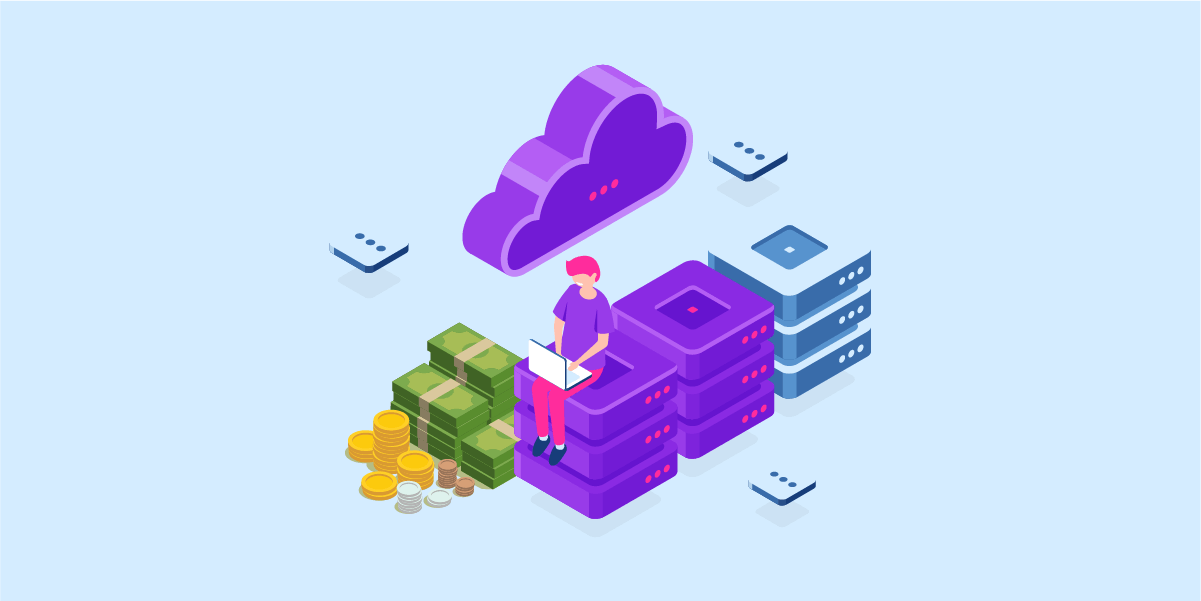Your Guide to Estimating the ERP Software Development Cost
The seemingly easy to glue together and operate suite of software that is meant to ease the day to day process of an organization, ERP is a lot more difficult to strategize and implement than its functioning lets by.
The engineering of an easy flowing frontend is powered by a much complex backend architecture – something that comes with attached ERP development cost. A cost estimate that is arrived at on the basis of features that are to present in the making of a good ERP system and the market that the system has made for itself.
In this article, we are going to help you understand the different factors that are entailed in the ERP software development cost.
But before we move on to that stage, let us first look into the advantages of Enterprise Resource Planning system that have contributed into the positive outlook of it in the industry.
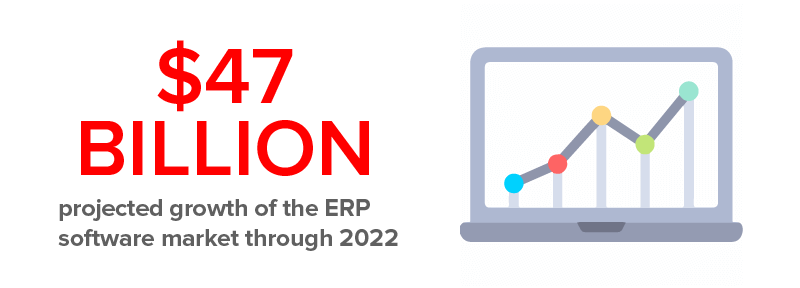
Why is ERP Important to a Company
The benefits of ERP system goes a lot deeper than simply automating day to day processes of a business. Let us look at some of those perks that make it beneficial to invest in ERP application development both for startups and established business.
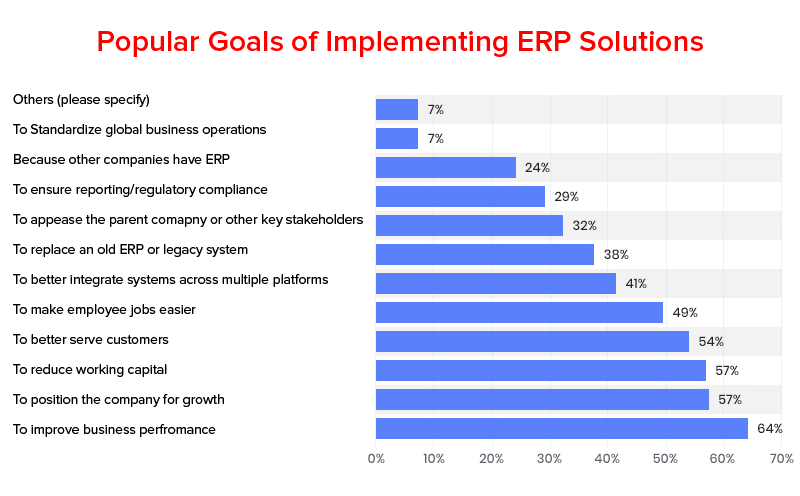
A. Streamlined Processes
The modern ERP systems are designed to bring all the data together, which ultimately improves the prevalent bottlenecks in the business process, something that single-handedly answers the question – is ERP good for small business?
When your processes get streamlined, you get following benefits at the back of it –
- Centralized Data is Money Efficient
Decentralized data is the main culprit that is known to cause chaos in any company, a situation that clouds businesses with inefficiencies. ERP systems gather the business’s complexity and convert them into easy to understand problems.
- Produces Opportunity for Automation of Workflow
The fact that almost all process of your business is fed in the ERP system helps you weed out the tasks which are repetitive in the product cycle and then automate it.
B. Better Tracing and Control
If your business deals in digital or physical products, the ERP systems can offer an easy approach to track your products. Here’s how the system make it possible –
- Visualizing the Service and Product Movement
One of the primal ERP benefits is seeing how services and products are moving in the pipeline. There are multiple ERP software vendors who offer tools that come with the efficiency of order tracking, revenue tracking, inventory, tracking, and raw material management.
C. Advanced Customer Service
One of the reasons why companies invest in custom ERP development is the change that the software brings to their customer service domain offering.
Here are the two ways your customer service domain is made more efficient through the ERP system.
- Better Aligned Suppliers and Customers
ERP software is known to improve both backend and frontend relation of business i.e. a relation that the company has with both their vendors and customers. An effect of which is streamlined shipping time and better customer experience.
- Prioritized Valuable Customers
The sales related information and data that is collected by the ERP system can be used to identify the repetitive customers – an information that can be used to nurture those clients better and study what strategy worked for them and then using the strategy across other customer silos.
Factors Affecting How much does it cost to develop and ERP
There are a number of different factors that carries a direct impact on ERP software development cost. It is these factors that differentiate a $75,000 system from a $750,000 ERP.
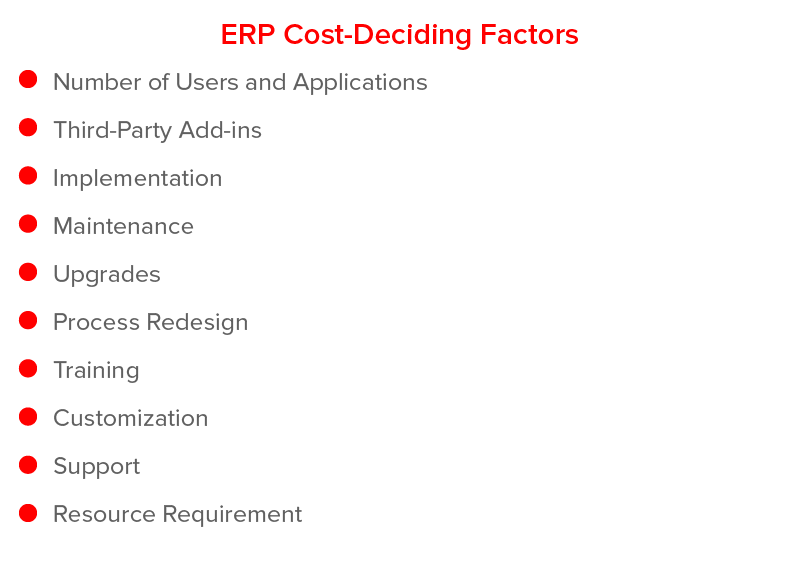
Let us look at what they are.
Number of Users and ApplicationsThe first ERP cost affecting factor is the number of users who will be working around it and the many ways they will be using it. While an ERP is usually expected to have these must-have features –
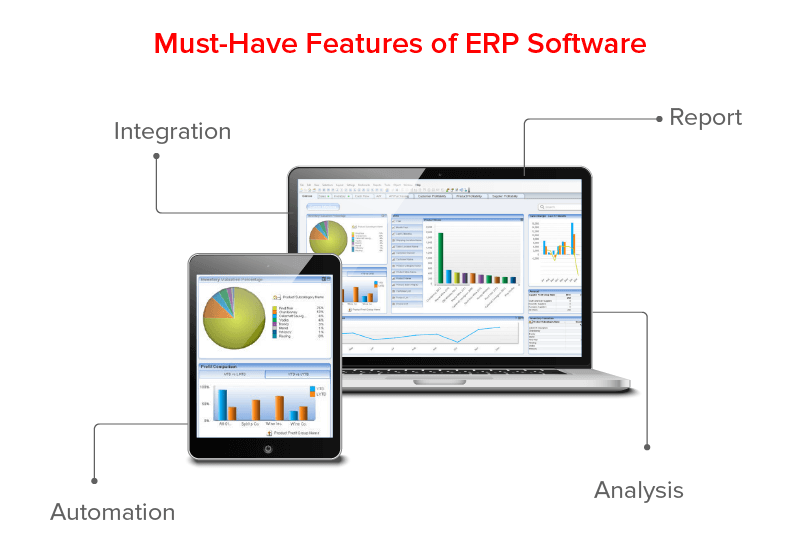
The more the features you add, the greater would be the overall ERP development cost. So, it is important to first gauge your exact requirement and then invest in a solution that matches those requirements. The right estimation can be one of the main strategies to improve the ROI of your system.
1. Software Add-ins
In order to offer a comprehensive range of services and functionalities to your employees, you will have to several third-party add-ins like Enterprise IMs tool or social media logins or one enabling scanning barcode, etc.
2. Implementation Cost
Adding your ERP system in your legacy system or simply adding a fresh system in the process would require a lot of time and efforts along with resource requirement. We have detailed the implementation process in much detail later in the article, jump there to know more about the process.
3. Maintenance
Until you are investing in cloud-based ERP solution, your on-premise system will require frequent and timed maintenance to ensure that the product is up and running as expected at all times.
4. Training
Explaining the ERP system to your team inside-out takes a fair amount of training that takes up not just your time but also a percent of your expense share.
5. Customization
Making the ERP system work on the exact model as your business requires some amount of programming from your in-house development or hired best ERP software development company.
6. Upgrades
The moment a new version of your ERP solution is announced, you will have to start planning the upgrade yourself. The last thing that you would want is your system becoming obsolete and inviting issues and bugs.
7. Process Redesign
When a business moves from a legacy system to an ERP system, it calls for a number of process redesign. And the same applies when you move from one ERP system to another, you will still have to bring some redesign to match your business process with software’s.
8. Support
Over the lifetime of the whole ERP system, you will come across a number of issues and bugs that you will have to solve and provide support for, to your system’s users – something that will come with a cost.
9. Technology Additions
The cost of your ERP system will automatically increase with the inclusion of technologies. The more technologies you add in the system, like Enterprise Blockchain or Artificial Intelligence, or even IoT, the greater would be your cost estimate.
10. Resource Requirement
The resources required to handle your entire ERP development, deployment, and implementation also adds on to the cost of the Enterprise Resource Planning system.
Besides the factors that are mentioned above, the pricing model is another thing that decides helps in deciding the cost whether you are going for Custom ERP Development or a Ready-Made solution – Pricing Models.
The Different Pricing Models of ERP Application Development
Commonly there are two main pricing models that are worked around by the ERP software vendors. Knowing these pricing models will help you understand the whole ERP software development cost better and also the cost of ERP implementation.
Here are the two models:
1. On-Premise Enterprise Resource Planning System
This ERP model makes it possible for businesses to host the system on their servers in their premise. This turns out to be a good option for big businesses for they have the necessary infrastructure and the manpower to handle a big ERP system.
There are attached pros and cons to this model like:
Advantage: It brings a well-defined ownership cost along with allowing a permanent license use without any concurrent subscription.
Disadvantage: The upfront implementation cost can be a turn off for SMEs also the infrastructure upgrade that the system could call for, can turn out to be pretty expensive.
2. Cloud-Based Enterprise Resource Planning System
This pricing model, supported by the likes of SAP ERP software and Oracle, etc. is an absolute hit among the small business enterprises – given that cloud-based ERP solution has a dedicated focus on flexibility and growth of a business. The number of ease that the on-cloud ERP system offers is the reason why we chose the model the first time we developed an enterprise system.
But like on-premise ERP system, Cloud-based ERP solution also comes with its fair share of pros and cons for businesses incorporating it.
Here are them both.
Advantage: The upfront cost is pretty low as compared to the execution and implementation of an on-premise system. Also, the subscription pricing that the model comes with is based on the number of users and transaction volume, which can always be altered depending on how the business is performing.
Disadvantage: For large business size, the subscription costs can be a lot greater than the cost of permanent license that can be utilized in case of an on-premise system. Also, the instant demand spikes can increase the costs under the on-demand agreement, making the management of cost a little too complex over a period of time.
Now that you must have gotten a fair idea of what pricing model is best suited when looking an answer to how do you set up an ERP system, let us come to one of the main parts of the whole ERP development and deployment process – ERP Implementation. Which also happens to be our last section in the short ERP software development cost pocket guide.
The implementation process of the ERP system as the name suggests is the process of adding the system in the everyday business process – the part that is hands down a very crucial part of the whole process specially when it comes to drawing out the ERP development cost estimation.
ERP Implementation Process and Timeline
The implementation of an ERP system in a business is the one factor that both success and failure of the ERP system ride on. When done right, it can take your business to great heights but when implemented wrong, it can make your otherwise averagely planned processes complex.
And this is the main reason why the step finds itself in the average ERP development cost estimates.
Well, let us look at what the ERP implementation process entails.
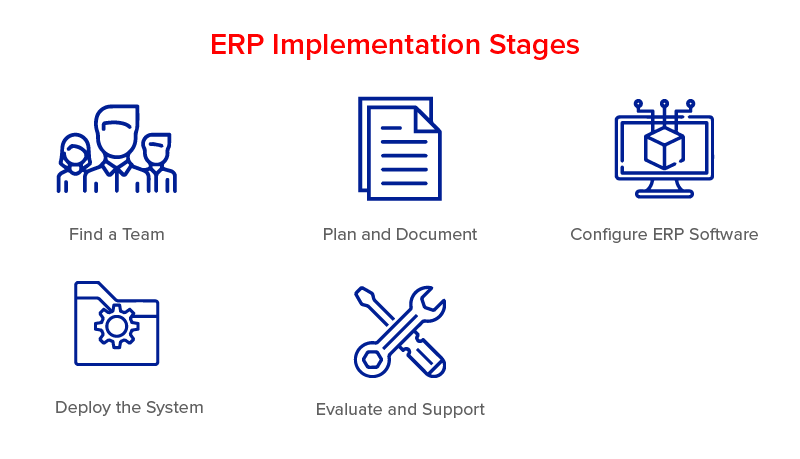
A. Find a Team
The first step of the implementation would be to find a team who would handle the whole process with the utmost ease. You will be needing a team of specialist ERP implementation experts for handling the evolution challenges, the data migration, and the whole transitional period.
Now, when you usually look for ERP Software Development in India, you get an implementation team made of:
- Project Managers
- Analysts
- QA Engineer
- Consultants
B. Designing of Plan
Before the whole implementation process starts, it is necessary to devise a clear plan to follow in the process to come. Doing this, the ERP manager would be able to foresee the weak link and reveal the core business processes.
The plan that you curate when manufacturing ERP software and implementing the system should include:
- Integration Steps – This should include data migration, schedule, launch activity, analysis, staff migration, and evaluation.
- Complete the Contracts – All the contracts for the new technology, software, and services should all be finalized at this stage.
- Infrastructure upgrades should be planned well in advance.
- Upcoming Challenges and Disruptions should be predicted, including – human, software, hardware, managerial, and communicational.
C. Configure ERP System
Out of the complete ERP implementation process, this is the one that is the most time-taking and cost inducing one. Here are the steps that are included in the whole configuration process –
- Analyze the gap between present and supporting application and processes
- Configure parameters which reflect new processes
- Complete the programming part of ERP configuration
- Migrate the data by first cleaning the existing data
- Test the system to deliver needed functionality
- Document the whole functional and the technical information
- Complete the necessary upgrades
D. System Deployment
Before the system is made available for everyone in the business to start using, there comes the stage of system deployment. There are a number of things that have to be attended at this stage –
- Staff Training
- The support team will have to be prepared to answer queries
- The system will have to be tested
- The Go Live decision will have to be made by the management.
E. Support and Evaluation of the ERP System
Once the ERP system is made live in the business, the whole process of evaluation and maintenance starts. This ongoing process looks into and takes care of the system to the T, ensuring that it is performing exactly as it was intended to.
This whole implementation process takes different time according to the different business sizes it is going to be deployed in. Usually, this is what the timeframe looks like –
Small Businesses – One to Three Months
Medium Businesses – Three to Six Months
Large Businesses – Six Months to a Year
Now that you must have got a basic idea of what to expect from the development and deployment of an ERP system in your business, it is time to get started. Get in touch with our team of ERP experts, today.

strategies your digital product..
